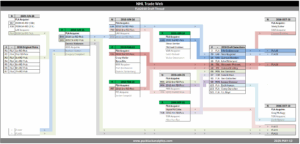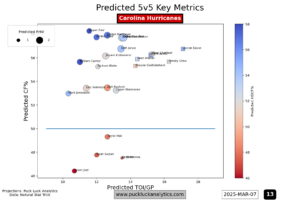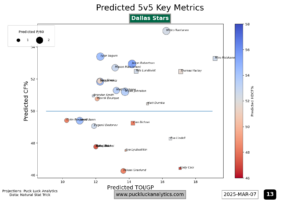The rebuild has become the de facto strategy to build a contending caliber roster in the NHL. It seems simple enough on the surface: sell off a lot of assets to stockpile futures, and draft a contending roster. Yet not all rebuilds succeed, so what separates the good ones from the bad? We’re going to look at a simple rebuild roadmap to investigate.
In my last post, I did a deep dive into the origins of the Florida Panthers 2024 Stanley Cup winning roster. That championship roster had roots that went back over 20 years and started to actually gain traction and climb toward a championship starting in 2010, 14 years before they lifted the cup. I noted there were similarities with the other cup winners from the past five years (Lightning x 2, Avalanche, and Golden Knights). The Lightning and Avalanche also executed deep rebuilds, while the Golden Knights started with their expansion draft in 2017.
Steps to a Cup Caliber Rebuild
Looking at the four teams that have hoisted Lord Stanley’s mug in the past five years, we can find some similarities in the way their rosters came together by normalizing their results and transactions in years before their cup win. We’re going to focus on two key areas: regular season point percentage and quantity of draft picks.


Step 1: Draft and Develop a Contention Cohort
If you’ve followed along here for a while, you’ll already know what I mean by a contention cohort. For those that may not be familiar, the contention cohort is the group of players that are expected to fill a majority of the positions in the top half to two thirds of the NHL roster when the team is fully in their contention window. These are elite players and strong support players and the most obvious place to acquire them is in the top 10 spots of the draft.
The logical way to start building an initial contention cohort in a full rebuild is to tear the NHL roster down, earn picks as high in the draft and draft high potential prospects for a few years in succession. Of course, holding a lot of picks during this time helps as well, since it increases the (small) odds of hitting a homerun with a later pick. The Lightning, Avalanche and Panthers all did this approximately 8-10 years before they won the Stanley Cup.
Initial Contention Cohorts:
- Lightning – Steven Stamkos, Victor Hedman, Andrei Vasilevskiy, Nikita Kucherov
- Avalanche – Gabriel Landeskog, Nathan MacKinnon, Mikko Rantanen
- Panthers – Jonathan Huberdeau, Aleksander Barkov, MacKenzie Weegar, Vincent Trocheck, Aaron Ekblad
You’re right, not all these players were on the cup winning rosters (looking at you, Florida). That’s fine. The point of this step is not to draft every piece that’s needed to win a cup. The intent is to add enough high end talent to the roster to start the climb and eventually be molded into the main structure of the contending roster. If we look at the regular season point percentage plot again, we see a common jump in the standings that hits it’s peak roughly 8 years before the cup win.
This jump is an indicator that the team has added enough top end talent to support a contending roster down the road. The contention cohort will not be good enough to support a true contending roster until years down the road. The real goal here is to develop this group so that they are a force when they hit their prime as a group, roughly…8-10 years down the road.
Case Study: When it goes wrong – Buffalo Sabres
So what happens when this step isn’t executed well? It’s pretty simple. The rebuild never gets off the ground. The Buffalo Sabres are the epitome of this failure. While the Sabres tear down started earlier, they landed back to back 2nd overall picks in 2014 and 2015, which they used to select Sam Reinhart and Jack Eichel. Problem was, they didn’t add enough talent with them to achieve liftoff. If we overlay the Sabres results, using the 24/25 season as ‘Season 0’, we see they failed to make that initial recovery in the standings around ‘Season -8’. Instead, the rebuild flatlined and their two prized picks went on to win cups with two of the teams we started with above.

Note: Although it wasn’t a true rebuild, the Golden Knights championship roster had a contention cohort built from players drafted approximately 8-10 years before their cup win as well. Jack Eichel was added to the cohort later, but it did include a number of the original Golden Knights including Chandler Stephenson, William Carrier, Shea Theodore, and Zach Whitecloud.
Step 2: Add a Secondary Cohort
While the contention cohort is the primary building block, it’s not enough to build a true cup contender. If the contention cohort is solid, it’s likely good enough to be a regular season force. The roster needs another injection of talent to push it into true contender territory though.
If we look at the quantity of draft picks each of the past five cup winners had, we see a peak about 4 years before the cup win where each team had a glut of draft picks. For two consecutive seasons in this timeframe, each team had more than their allotted 7 draft picks and it’s a noticeable bump in the trendline. The secondary cohorts included players like Anthony Cirelli and Ross Colton (TBL); Cale Makar, Bowen Byram and Alex Newhook (COL); Paul Cotter and Peyton Krebs (VGK); and Anton Lundell, Spencer Knight, and Cole Schwindt (FLA).
Some of the players from these groups became important pieces for their team’s respective cup run. Others became trade chips that helped land high impact players for their drafting team’s cup run. Either one, or a combination of both, works. The key objective is retaining and adding value to the roster. The teams didn’t acquire the extra picks by ‘going all in’ and trading away their picks at this stage. Instead, they turned over some assets they either couldn’t or didn’t want to keep and added additional future potential.
Case Study: When it goes wrong – Toronto Maple Leafs
What happens when the secondary cohort is not built? Look no further than the Toronto Maple Leafs. Regular season wonders, they’ve been unable to make their mark in the postseason with a contention cohort boasting the likes of Auston Matthews, Mitch Marner, William Nylander and Morgan Reilly. The group was good enough to achieve an initial standings recovery similar to the cup winners if we use the 24/25 season as ‘Season 0’.

There’s a big difference from the cup winners at the draft table though. Instead of building a secondary cohort, the Maple Leafs went all in earlier than their cup winning peers and choked off their prospect pipeline. Instead of supplementing their contention cohort with a drafted secondary cohort with high value contracts like ELCs, they spent futures to supplement it with rentals and filled gaps through free agency. Both are difficult ways to find and retain roster value over the long term.

Step 3: Patience
Rebuilds take time. We’ve seen above that the four of the past five Stanley Cups have been won by teams that have executed rebuilds and the one that didn’t was an expansion team that followed similar principles. The timelines are similar for all of them. A rebuild is a decade in the making, if not more.
There are room for bumps along the way. We saw in the Panthers Rebuild Review that Florida tried to accelerate with rentals between building their contention cohort and building their secondary cohort. It didn’t work. In fact, perhaps it caused the construction of their secondary cohort.
We also saw in the Panthers Rebuild Review that the drafted contention cohort may not be the final group that wins a cup. Jonathan Huberdeau and MacKenzie Weegar were jettisoned when they could net the Panthers Matthew Tkachuk. The Golden Knights make a similarly big swing to add Jack Eichel. And there are multiple instances where the contenders leveled up by jumping on value deals, like the acquisitions of Sam Bennett by the Panthers and Devon Teows by the Avalanche.
There are moves to be made to continually better the team. What’s paramount in it is all, though, is patience. The contention cohort is the key to the entire process. If it is not managed carefully through the entire rebuild timeline, it can collapse the entire effort as quickly as a Jenga tower.
Case Study: When it goes wrong – Calgary Flames
I was in at the Saddledome the night that Jarome Iginla was traded to the Pittsburgh Penguins. There was a restlessness in the building that night when those in attendance realized that #12 was not on the ice for warmup. It signaled the end of an era in Calgary and the start of a rebuild. Conveniently, that was in 2013 and it fits our timeline to set 24/25 as ‘Season 0’ again.
The Flames completed both Step 1 and Step 2 above, yet they are staring another rebuild in the face rather than looking at their reflections in the Stanley Cup. What happened?
They started by drafting a contention cohort that included Sean Monahan, Matthew Tkachuk, Adam Fox, Rasmus Andersson, Oliver Kylington, and Andrew Mangiapane. Johnny Gaudreau was on the perimeter as well, drafted a couple of years ahead of this group.

The Flames started their climb back into relevance with this group. Not quite as immediate as the cup winners, but a steady upward trajectory after the contention cohort was drafted.
They added a secondary cohort as well, with 8 picks in each of the 2020 and 2021 drafts. They added Connor Zary and Matt Coronato during those drafts, who could have been good support pieces to the group above.

Except the group above collapsed before they had the chance. In 2022 (ie. ‘Season -2’), the contention cohort fell apart. There were a multitude of reasons, but a multitude that point to a front office pushing too hard, too quickly. The Flames started adding through free agency very early, seeming trying to accelerate out of their rebuild quickly. Signings like James Neal and Troy Brouwer were common, eating cap space and plugging up roster spots.
Matthew Tkachuk was a holdout into training camp on his second deal with the Flames tight up against the cap. Perhaps that soured the relationship with the team, ultimately leading to Tkachuk forcing his way out a year before UFA eligibility. Sam Bennett was seemingly never slotted in the lineup in a place where he could succeed. Rather than develop him, the Flames had ‘trusty’ veterans like Brouwer playing up the lineup as they tried to win now and he arrived in Florida in a value deal when the Flames seemingly gave up on him. Sean Monahan may have lost his best years after playing through two (2!) hip injuries as the Flames chased playoff spots and was ultimately traded away with(!) a 1st round pick to shed cap. Johnny Gaudreau left for family reasons, yet Flames held on until the 11th hour hoping to convince him to stay.
Without the patience to properly develop and supplement their contention cohort, the Flames set in motion a combination of crippling circumstances that were years in the making. Cap space is required for the contention cohort. Suitable lineup positions to develop the contention cohort are required. By chasing an early exit from the rebuild, the Flames made both those objectives secondary and toppled their contention cohort just as it was entering it’s prime.



